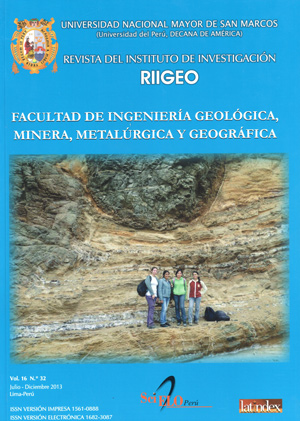Methodology for oil extraction Nannochloropsis oculata microalgae using ultrasound
DOI:
https://doi.org/10.15381/iigeo.v16i32.11345Keywords:
Microalgae, extraction, ultrasound, toxicity, environmentAbstract
Many methods have been reported for the extraction of oils from microalgae, either for food, medicinal purposes and recently as feedstock to produce biofuels. For the production of biofuels such as biodiesel generally are used oilseeds which have shown to have many limitations due to the availability of land and water for cultivation, low crop yields and more so that seeds are used to food. For this reason in recent years have been studying the feasibility of the use of microalgae to produce biodiesel which can overcome the above limitations. Several authors have methodologies for extracting of different microalgae oil whose ranges of extraction are on the order of 11.2% to 22.9%.
This work presents a modified (improved) oil extraction method from the microalgae Nannocloropsis oculata previously lyophilized using ultrasound treatment in a mix of
organic solvents cyclohexane-isopropanol and chloroform-methanol.
The highest yield was achieved with chloroform-methanol (35.55%±2.05) mixture, but are considered to have a negative effect on the environment and health, so the cyclohexane- isopropanol mixture showed acceptable performance (31.49% ± 0.11) being less polluting to the environment. The sonication time of the samples of the Nannochloropsis oculata microalgae showed no significant effect in the yield of oil, and 10 minutes proved to be adequate and the optimum temperature when working for a period of 10 minutes for both cyclohexane-isopropanol mixture and chloroform-methanol mixture resulting time. Only to the extraction temperature had variations being the ideal 56 °C for cyclohexane-isopropanol mixture and 48°C for chloroform-methanol.
When working with the cyclohexane-isopropanol mixture, changes in the sonication times showed no significant effect, and 10 minutes proved to be adequate and the optimum temperature, 56°C. For the chloroform-methanol mixture, although there were some slight variations, it was found that 10 min sonication may also be appropriate at 48°C ideal temperature.
Downloads
Published
Issue
Section
License
Copyright (c) 2013 María E. Fuentes Campos E. Fuentes Campos, Marleny D. Aranda Saldaña

This work is licensed under a Creative Commons Attribution-NonCommercial-ShareAlike 4.0 International License.
AUTHORS RETAIN THEIR RIGHTS:
a. Authors retain their trade mark rights and patent, and also on any process or procedure described in the article.
b. Authors retain their right to share, copy, distribute, perform and publicly communicate their article (eg, to place their article in an institutional repository or publish it in a book), with an acknowledgment of its initial publication in the Rev. Inst. investig. Fac. minas metal cienc. geogr.
c. Authors retain theirs right to make a subsequent publication of their work, to use the article or any part thereof (eg a compilation of his papers, lecture notes, thesis, or a book), always indicating the source of publication (the originator of the work, journal, volume, number and date).






